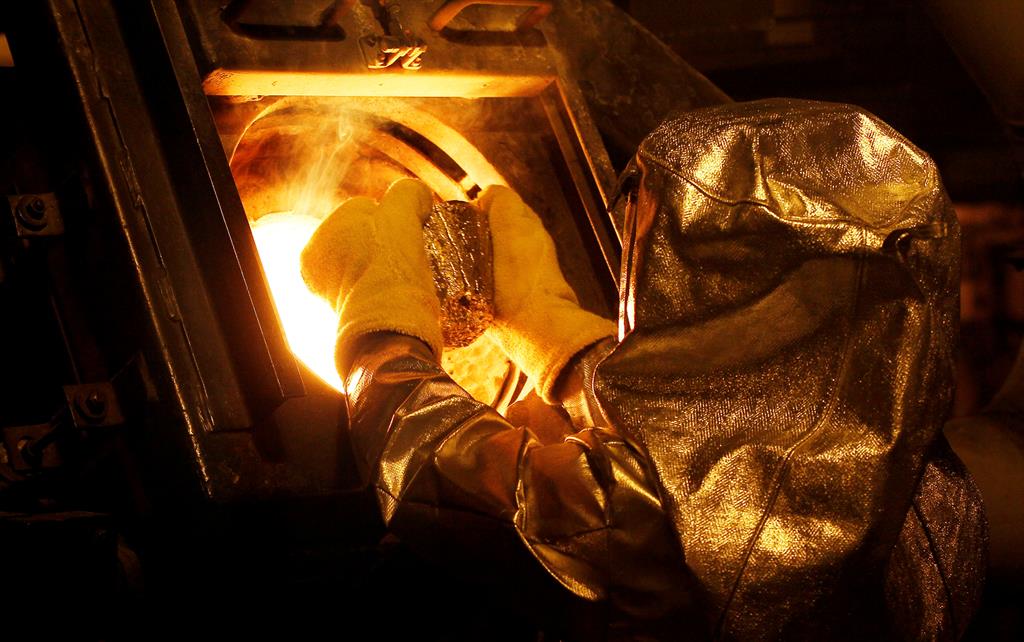Dimmer production year for Otjikoto
Capital expenditure at the Otjikoto gold mine last year exceeded N$700 million.
Jo-Maré Duddy
The Otjikoto mine in the North last year contributed nearly 18% to majority shareholder B2Gold Corp's record annual consolidated gold production of 953 504 ounces.
Releasing its 2018 annual results yesterday, B2Gold said Otjikoto produced 167 346 ounces of gold last year. Although lower than 2017 production, Otjikoto last year still delivered above the mid-point of its guidance range of between 160 000 and 170 000 ounces.
Compared to 2017, Otjikoto's production dropped by 24 188 ounces or 13%. B2Gold said the lower production was expected and was due to a “negligible” amount of Wolfshag ore being mined last year while Phase 2 of the Wolfshag Pit was being developed. Higher grade ore production is planned to resume from the Wolfshag Pit in late 2019, the company said.
Otjikoto's production for the year resulted from processing 3.4 million tonnes - compared to a budget of 3.3 million tonnes and 3.5 million tonnes in 2017 - at an average grade of 1.53 g/t, compared to a budget of 1.57 g/t and 1.73 g/t in 2017. Average gold recoveries in 2018 were 98.7% compared to a budget of 98.0% and 98.6% in 2017.
For the full-year 2018, Otjikoto's cash operating costs were US$502 per ounce, up nearly 7.3% from the previous year. All-in sustaining costs (AISC) were US$719 per ounce, a year-on-year increase of 0.6%. Both were near the mid-point of their guidance range, B2Gold said.
Capital expenditure last year totalled $51 million – about N$735 million at yesterday's exchange rate. This included pre-stripping costs of US$27 million, mobile equipment rebuilds of US$12 million and US$4 million for the installation of the Otjikoto solar power plant.
Outlook
B2Gold is forecasting production of between 165 000 and 175 000 ounces of gold this year at Otjikoto. Production will be primarily from the Otjikoto Pit, at cash operating costs of between US$520 and US$560 per ounce and AISC of between US$905 and US$945 per ounce.
“Gold production is scheduled to be significantly weighted towards the second-half of the year (as a higher-grade zone of the Otjikoto Pit is forecast to be processed in the third quarter of 2019 and high-grade ore production from Phase 2 of the Wolfshag Pit is scheduled to begin in late 2019),” the company said.
B2Gold Corp owns 90% of the Otjikoto mine through its local subsidiary, B2Gold Namibia. Evi Gold, a local empowerment group, owns the rest.
The company – which also owns the Masbate Mine in the Philippines, the Fekola Mine in Mali, as well as the La Libertad Mine and El Limon Mine in Nicaragua - is listed on the Toronto Stock Exchane (TSX) and on the Overall Index of the Namibian Stock Exchange (NSX).
B2Gold ended at N$38.21 per share Monday on the NSX. The share has gained about 7.4% since the beginning of the year.
The Otjikoto mine in the North last year contributed nearly 18% to majority shareholder B2Gold Corp's record annual consolidated gold production of 953 504 ounces.
Releasing its 2018 annual results yesterday, B2Gold said Otjikoto produced 167 346 ounces of gold last year. Although lower than 2017 production, Otjikoto last year still delivered above the mid-point of its guidance range of between 160 000 and 170 000 ounces.
Compared to 2017, Otjikoto's production dropped by 24 188 ounces or 13%. B2Gold said the lower production was expected and was due to a “negligible” amount of Wolfshag ore being mined last year while Phase 2 of the Wolfshag Pit was being developed. Higher grade ore production is planned to resume from the Wolfshag Pit in late 2019, the company said.
Otjikoto's production for the year resulted from processing 3.4 million tonnes - compared to a budget of 3.3 million tonnes and 3.5 million tonnes in 2017 - at an average grade of 1.53 g/t, compared to a budget of 1.57 g/t and 1.73 g/t in 2017. Average gold recoveries in 2018 were 98.7% compared to a budget of 98.0% and 98.6% in 2017.
For the full-year 2018, Otjikoto's cash operating costs were US$502 per ounce, up nearly 7.3% from the previous year. All-in sustaining costs (AISC) were US$719 per ounce, a year-on-year increase of 0.6%. Both were near the mid-point of their guidance range, B2Gold said.
Capital expenditure last year totalled $51 million – about N$735 million at yesterday's exchange rate. This included pre-stripping costs of US$27 million, mobile equipment rebuilds of US$12 million and US$4 million for the installation of the Otjikoto solar power plant.
Outlook
B2Gold is forecasting production of between 165 000 and 175 000 ounces of gold this year at Otjikoto. Production will be primarily from the Otjikoto Pit, at cash operating costs of between US$520 and US$560 per ounce and AISC of between US$905 and US$945 per ounce.
“Gold production is scheduled to be significantly weighted towards the second-half of the year (as a higher-grade zone of the Otjikoto Pit is forecast to be processed in the third quarter of 2019 and high-grade ore production from Phase 2 of the Wolfshag Pit is scheduled to begin in late 2019),” the company said.
B2Gold Corp owns 90% of the Otjikoto mine through its local subsidiary, B2Gold Namibia. Evi Gold, a local empowerment group, owns the rest.
The company – which also owns the Masbate Mine in the Philippines, the Fekola Mine in Mali, as well as the La Libertad Mine and El Limon Mine in Nicaragua - is listed on the Toronto Stock Exchane (TSX) and on the Overall Index of the Namibian Stock Exchange (NSX).
B2Gold ended at N$38.21 per share Monday on the NSX. The share has gained about 7.4% since the beginning of the year.







Kommentaar
Republikein
Geen kommentaar is op hierdie artikel gelaat nie